A reader asks about the possible Martin D-45 vs HD-28 differences in tone, two guitars seemingly identical in their woods and construction, but one with more expensive abalone shell trim.
Val from California asks:
The Martin D-45 costs $6,950 more than the HD-28, but they seem to be the same guitar on paper, other than the cosmetic trim. Is there any difference in sound between these two models?
Thank You!
Spoon writes:
Thank you for your question, Val. You are not alone in wondering if the difference in price between these two excellent guitars can be heard in their tone.
You were quoting the difference in list price, by the way. The street price difference is more like $4,150. Still, we are talking basically twice the price of the HD-28.
The difference in cost is partly because of the higher grade rosewood and spruce. But Martin does their grading solely on looks. While the D-45 has a neck that is bound with white plastic, the majority of the price hike has to do with the 900+ pieces of abalone shell inlaid on the front, sides and back of the D-45, and the hours of labor by the master craftspeople who do the inlay work.
It has been maybe 20 years ago that I first posed the very same question in the forum at Acoustic Guitar Magazine, and similar places on the internet. At that time, I was busily using my senses in every guitar shop in New York City, in search for my first Martin. I so loved the look of the D-45 and OM-42, and I kept trying to find one with a voice that would make me pay the extra money to buy it. I never did.
No matter where I went and what I played, I always liked the tone of the 28s more. And the difference I kept hearing was consistent.
I ended up with a Custom 15 (as the HD-28V was then called) and eventually an OM-28VR, because of how they sounded. There was an extra element to the sound of the 45s, which I did not particularly care for. It was similar to liking cupcakes with sprinkles until I tasted them and didn’t like that extra sugar. I would ask strangers in shops to tell me it was my imagination, but they all heard it too. And I have heard the difference between 28s and 45s ever since.
For years, people on the internet have claimed someone hearing a difference between a 45 and 28 are simply making themselves believe the difference exists to justify the price. That was certainly not the case for me. I wanted to like the sound of the D-45s as much as the D-28s, but it wasn’t happening, ever.
I remain surprised when people say they cannot hear what is obvious to my ears. But then, I feel the same way about those who cannot hear the difference the dovetail neck joint makes compared the M&T neck joint, or the difference between guitars made with a rosewood bridge or an ebony bridge, or made with Brazilian compared to Indian rosewood, or hide glue. And about a week ago a fella on the Martin guitar forum said he recorded similar guitars with one having forward-shifted braces and one without, and he and a group of his associates failed to detect any difference in their sound.
Yes, after playing countless Martins in Style 28 and Style 45, I know the difference in tone is certainly there, and it is something I grew to appreciate in the pearly Martins more and more. However, the difference is subtle, so it makes sense to me when some people claim it does not exist at all.
I am glad you did not ask me if the difference in tone between the two guitars justifies the price. That is a matter of personal taste. I would say no, someone does not buy a 45 and pay all that extra money because it sounds that much “better.” But it certainly does not sound exactly the same.
I know an awful lot of people who hear the difference, and are happy to spend a lot for multiple examples. All of them are buying their 45s for their physical beauty, their rarity, and the craftsmanship that goes into them as much or more than the tone. But they also buy them for the tone too.
A Method of Comparison
Even with very similar wood, it is hard to find a pair of guitars of different models that contain only a singular difference. The Standard Series D-45 and HD-28 provide a better direct comparison than most. The paring is basically identical in all respects except for the cosmetic grade of the tone woods, as well as the 45’s pearl trim and bound fingerboard.
FYI the 000-42 and the 000-28EC are also identical, and good for comparing smaller bodies in the same way. Style 42 shares the same specs as Style 45, but the pearl trim appears on the front only.
However, if one wants to be remotely scientific in such an investigation, they must sample a great many parings over time, in different environments, before deciding if consistent patterns emerge. During the past quarter century, I have been able to do exactly that.
Quite a Pair (click to enlarge)
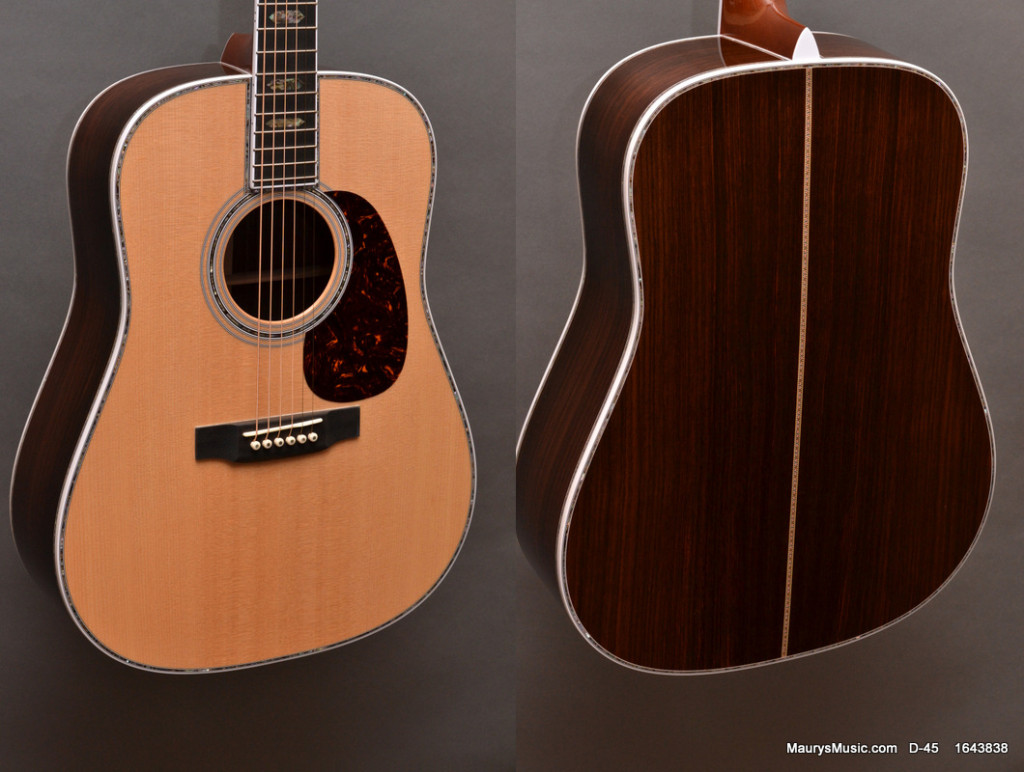 Photos: Maury’sMusic.com Photos: Maury’sMusic.com |
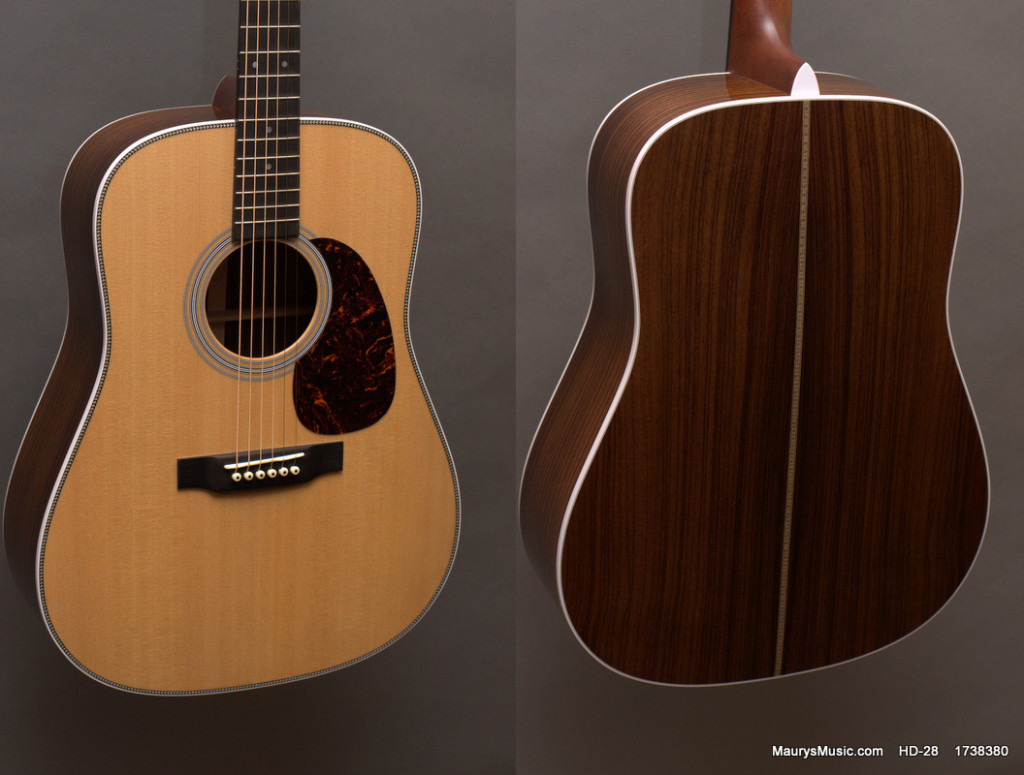 |
Far From Standard
First of all, both of the guitars you mentioned are world-class, professional level instruments, made out of all solid wood, with Indian rosewood for the back and sides, tops of high-grade Sitka spruce, ebony fingerboards and bridges, and one piece mahogany necks. They also have the scalloped bracing of the same pattern and position.
As the official top of the line, the D-45 has the highest grade wood. Although Martin grades its wood on looks alone this does not automatically mean it has no effect on tone, especially where spruce soundboards are concerned. It remains controversial as to whether visually noticeable features of physical structure translate to tonal properties. But even the lowest grade spruce at Martin is quartersawn and of higher quality.
Since many non-pearled Martins are ordered with Grade 8 spruce tops used on 45s, why would they sound differently? The elephant in the room is the abalone shell.
It is not coincidence that abalone became a universal standard for fancy trim. According to Peter Szego, an authority on the evolution of the acoustic guitar, it was only one of many non-wood materials used for cosmetic marquetry over the centuries, but it survived all the rest because purfling can indeed effect tone and often for the worse. That is not the same thing as saying abalone makes a guitar sound better. I never go so far as to claim that. But I do believe it can make a guitar sound differently than similar guitars that do not have it inlaid in the thin tonewoods.
Heretical Thinking
Back during my original comparisons, it became noticeable that the 45s had everything the 28s did, but there was this extra “stuff” on the edge of the voice, or down inside it. It was too busy, somehow – distracting. A reverb or a “jangle” as I called it then. It was like the voice was wearing spurs.
I realize now that my word choice was slanted in the negative direction, because I did not care for it. Shimmer might be more accurate, for what my ears perceived in the first moments that followed a strummed chord, or in the harmonic bloom of sustained notes, where a played note sustains until sympathetic harmonics sound from other strings. In any event, it did not sound like WOOD to me, or at least what my brain was looking for in “the Martin sound.”
Then again, the 45 to 28 difference is pretty subtle stuff, and not nearly as noticeable as the difference between Adirondack and Engelmann spruce tops, for instance. Adirondack spruce can add a similar glimmering property to the high end of a guitar, but the Adi topped 45s have a lot more of that shimmer or complexity or presence going on than Adi 28s. Over all, what I consider to be the pearl trim difference is about on par with the degree of difference in the complexity of Brazilian rosewood compared to Indian rosewood. Then again, some of the same people will say there is no tonal difference there either.
It is not something that stands out on recordings made with $100 microphones and low-end preamps. But it never stands out in any case. Rather, it glimmers here and there, and adds some extra definition to the voice like subtle savory spices in a prepared dish of food. Perhaps the 28s have it all too, but the 45s have more of whatever “it” is.
Over the years, I came to like the 40s Martin sound. Most of my rosewood Martins have been made in styles below the 40s, but I have owned a couple of 42s and they sound noticeably different than any other guitar I have owned, and in the same way.
All and all, even though I have come to appreciate the extra stuff in the voice, I certainly do not feel the price involved to own it is justified by the difference in the sound alone.
Sensitivities
I notice that most players who are adamant about there being no tonal difference between a D-45 or OM-42 and non-pearl Martins do not own or spend much time playing D-45s or OM-42s. Or they are obvious at other times in their own prejudice against flashy trim, or perhaps they wish to believe their 28 or 35 is every bit as good as the guitar that costs twice as much, basically the reverse of their own claim about those who do hear the difference. I have also met a grown man convinced that the standard D-28 sounds no different from his DR, made from laminated rosewood with simplified bracing, and an M&T neck joint.
But I also know more than one seasoned guitarist who has never owned a pearly Martin yet claim they often recognize a 40 Series Martin being played behind their back, and one such person recently said it happens to him often in the hotel at Martinfest, where he can tell it is a 40s Series guitar from its sound alone, before he turns around to confirm the presumption.
Hear For Yourself
I encourage everyone to go find a shop that has pairings like an OM-42 and OM-28, 000-42 and 000-28EC, HD-28V and D-42, and of course the D-45 and HD-28, and play as many such pairs in the same place on the same day and see for themselves, in person, with an acoustic instrument and their own ears, if they do not hear the similarities between the 42s and 45s that do not appear in the 28s and vice versa.
I encourage them to do so with at least one friend, preferably a younger friend who has not lost any of their high frequency hearing, and see if they agree or disagree. Better yet, do not let on to what the point of the experiment is, just see if they start to hear the similarities, or not.
Not the Only One
When I started mentioning this odd discovery in forums, I was crucified via the most offensive and personal attacks I had ever witnessed (at that time anyway.) That was until some three or four professional guitar builders spoke up to say they actually agreed with me, and in the case of one thread on AG or the 13th Fret, hijacked it for their own discussion, which quieted down the flamers. These luthiers did not always agree as to WHY a guitar with Style 45 type pearl trim would sound different than a guitar that did not have it, but they all supported my position, because they heard the difference too.
Many years later, sitting in an attic in New Jersey with Wayne Henderson and TJ Thompson, as they discussed repairing pre-war 45s, I asked them about it, and there was agreement, with Wayne saying, “the 45s always seem to sound different.” They thought my reasoning was interesting, but didn’t really have an opinion one way or the other as to why they might sound differently.
The Martin Museum’s 1942 D-45 (click to enlarge)
|
Photos: J. Caleca |
If So, Why?
My original ideas went along this line: Everything that influences the transference of energy leading to the voice of the guitar has some effect upon that end sound. There are two specific aspects that may play a part in this proposition about abalone inlay – the thinning of the top required to insert the inlay, and the material used for the inlay itself.
The guitar top is basically a diaphragm, like the head of a drum. And it transfers energy to the tonewood body and receives vibrating energy back. Most everyone agrees the soundboard is the single most important factor when it comes to the “color” in a guitar’s voice.
Often the builder will cut a trench to inlay purfling around the edge of the top. But that makes the top even thinner exactly where that diaphragm anchors to the sides, which should effect how that top flexes or “breathes,” as some say. Some players and builders think guitars that have no inlay around the top at all sound differently than those that do, because of that extra flexibility.
Now you take that trench and you fill it. Some resonant energy will make its way to the sides and back through the remaining top wood under the purfling, but some of it must travel through the purfling. And it made sense to me that the substance you fill it with is going to filter or otherwise transfer vibration differently than other substances, as they make their way to and from the top and sides.
Down where things are measured in microns, herringbone trim like that on an HD-28 is basically a tiny cobble stone sidewalk, made with bits of plastic or maple wood, with each shallow “brick” pointing in alternating angels from each other, and each with a tiny crack around it, so any vibrations are not passing directly through solid wood, but have to pass from one piece to another, with space between each, which may in some way alter energy passing through the sidewalk.
Abalone purfling is laid down in large slabs of varying length. Some of it is solid shell, but most used today is a veneer, which insures a top layer of the best looking stuff. In either form, it is much denser than wood or plastic by a long ways.
Abalone shell is unlike most other natural material, as it consists of aragonite carbon crystals, laid down in strata, with a layer of protein interlocked between each layer of aragonite, making it so hard that abalone shell is used as the model for hi-tech bullet proof armor. It makes sense to me that such a material would have some effect upon any sort of vibrations passing through it, as would other materials in their own way. Perhaps it is filtering the vibrations to alter or remove something that would otherwise show up in the audible tone, not unlike how rosewood and ebony bridges affect the tone of a guitar differently. (I recommend trying some Martin M-38s with ebony bridges and some with rosewood.)
But a bridge is much more involved in resonant energy transference than very thin purfling around the top. Well, one of those luthiers who came to my defense suggested it was not the pearl at all, but that the trench cut into the top for pearl was wider and deeper than one made for wooden purfling, and this could account for the difference in resonant vibrations that ultimately show up as sound. And when it comes to the 45s, the builder is doing the same thing to the sides and back, so all four walls of the “sound box” would breathe more easily and be more flexible during playing than a guitar that did not have the extra purfling.
And the Answer Is…
“Does the pearl trim on a D-45 effect its tone?” For me that question was settled long ago. When asked, my response is to ask why it would not. No one has ever offered even an unsatisfactory answer.
My short answer to your question is, just about everything that goes into making an acoustic guitar has some baring on how it vibrates with physical energy that gets translated into audible sound. Style 45 guitars do sound differently from Style 28 guitars. The query really is, to what degree does it have an effect, and is it easily perceptible enough to matter, in terms of preference or price? That depends on the listener.
The master luthier George Lowden was somewhere near 60 years of age when he came to the conclusion that different species of spruce tops really do make a difference in the sound of a guitar. Fingerstyle guitarists Howard Emerson has at times glued strips of felt onto his head stock, to deaden the harmonics that he at least could hear ringing off the strings of a Martin guitar between the nut and the tuners.
Clearly, some people hear things when listening to guitars others do not notice.
Personally, I have yet to play a D-28 in any configuration that sounds like a D-45 Stephen Stills or a D-45 Authentic 1942, no matter what top or bracing it has. If someone cannot hear that difference, then they had better like their high-priced D-45 for other reasons, as there is no point in paying for what they can’t hear.
So, while part of me feels sorry for people who can’t hear the difference between an HD-28 and a D-45, or an OM-28 GE and an OM-45 GE, another part of me envies them. They blissfully don’t know what they are missing.
And that is one man’s word on…
Martin D-45 vs HD-28 Differences
Find more Reader’s Questions in Spoon’s Mailbag
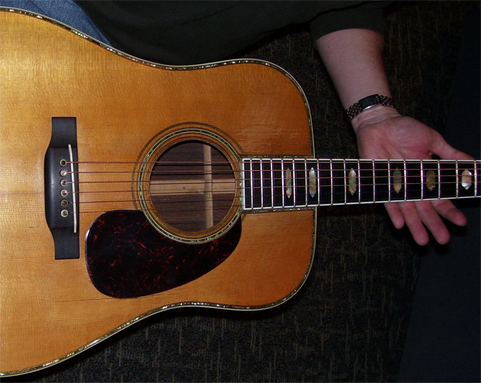
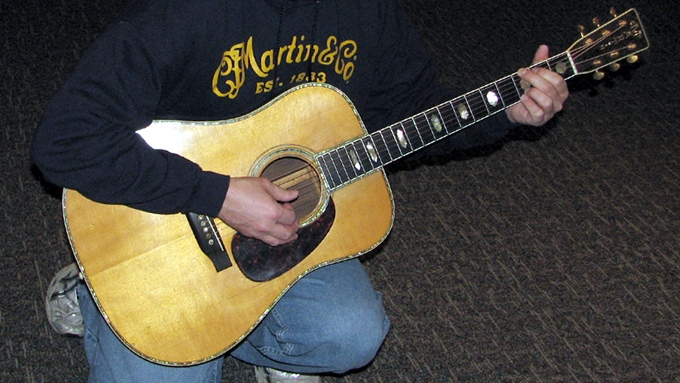
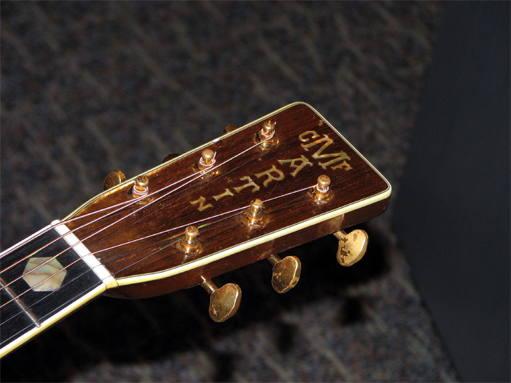
Hi Spoon, another fine piece. I’m inclined to think it’s all about the individual player’s ears and how old or young those ears happen to be. I mean, I’ve grown very attached to my very ordinary, D1, despite its laminated sides. My 71 year-old ears tell me about its many shortcomings, but with no great effort on my part, we seem to have reached a comfortable accommodation, in the sense that it forgives my awful musicianship and I forgive its less than muscular treble delivery.
Thank you, Herr Von Barrhead, if that is your real name. Or does this mean you hail from Alberta?
The D-1 is a very good guitar and I have always enjoyed playing them. I had a flatmate for some years who bought one when they first came out, so I got to play and hear it quite often. And I agree that tone is entirely a personal matter, when it comes to what decides the voice of a particular guitar or type of guitar is “good” or “better” then others. I am happy you love your Martin.
Great article! A little off hand here, but I’m looking for a template of a 1941/42 D45 pickguard like pictured above by J. Caleca. I was wondering if you could help by chance? Thanks.
Hi and thanks.
Sorry, I have no knowledge of where to get such a thing. However, I would assume the someone among the many restores of vintage Martins would likely know. I would try to contact T.J. Thompson, or the guys at Brothers Music in Wind Gap, PA, or John Arnold. That would be a good start.
Very interesting reading. I really love your “scientific” Approach!
I also find very interesting the fluctuations within a production line. My personal observations show that they are far bigger than I assumed. Even in the top lines. And probably more relevant than the effect of abalone on a particular guitar. While most guitars of the better lines are “very good” sounding, some I encountered where “stellar” and often much louder than the same model right next to it. This would be a good subject for an investigation. Best, Chris
Thank you, Chris. While I try to apply the scientific method throughout my life, my guitar investigations are of course limited by my sample sizes and the fact sensory perception is never exact, but rather subject to many variables.
While I agree with you that three or four Martins of the exact same model, hanging side by side in a shop, sound differently, each with their own personality, I will say each may be considered “stellar” by someone. As the saying goes, one man’s meat is another man’s poison.
I have experienced this in real life, when playing guitars at a NYC shop and thinking one particular Martin was a dead dog compared to its siblings. And within the hour someone else came in and bought that very guitar, after playing it in comparison with the others sitting along side it. Clearly, what did it for him isn’t what does it for me when it comes to tone and dynamics.
I feel the number one factor in why guitars can vary so much when all else is equal has to do with the soundboard. Each piece of spruce is unique. Some are just more alive than others. Some go through a waking up period, sometimes each time it is played, and all of them will evolve their voice over time, depending on how they are played.
A good example of this is found in the “dead man’s note.” That is a phrase I coined for the note fretted at the 9th fret, on the A string. It seems to be the least resonant note on a guitar. Actually, it is more noticeably devoid of life on long-scale guitars, more than short-scale guitars, and on guitars made with a traditional dovetail neck joint than bolt-on necks.
The point is, as dead as that can sound (and just like other factors, it can sound more dead on one guitar than another of the same model,) that note will wake up and become much more resonant the more it is fretted and played by the owner of the guitar.
Will that note improve without being singled out for playing (say, by someone who never plays above the 5th fret) because the top is resonating and all frequencies improve over time? Or will that note on that guitar continue to have less sustain and resonance compared to a guitar that gets played up the neck with great frequency? An interesting question.
But yes, you are correct, that the guitars vary within the same model, even the top of the line guitars. But that does not change the fact that over a period of years I began to identify that particular “something” that persisted in guitars with pearl trimmed tops, across many samples. As with all aspects of guitar tone, it was more noticeable in some more than others. But it was never missing entirely.
Yes, I agree with you on everything. You can always argue about sound, but it seems to me, absolutely independent from these qualities the volume. We all perceive some guitars as louder than others. And I think we all agree that in sessions it is a fundamental advantage. I once played a factory new D18 GE that I didn’t bought because it scared me off by I its raw power. It had an almost “distorted”, electric quality to it. As you can imagine. It haunts me still:) I then bought a pretty average ” nice sounding” D 18 GE, which I traded in the meantime for a D 28 Marquis. A real loud beast that puts my friends D 45 Marquis to shame. It is a great pleasure to play one of these well working tone machines that need so little energy. Playing them softly is like cruising a Ferrari. Best, Chris
I wish I had thought up the Ferrari line, well said!
Volume can be important to many players. But if it was all important to all players, no one would be playing 00s or 0s. Power and volume can be extremely seductive, however. Which is why so many people own at least one dreadnought. And they can be important in ensemble playing, as you pointed out. Even when plugged in and playing through a PA, some guitars do not have the same volume increase as some other guitars, when the player digs in with the pick for solos. And that can be true when comparing guitars of the exact same model. Having guitars built from natural materials just offers such variety of dynamics, response and tone.
Hi.
I just found this link today.
Wonderful reading and I appreciate your thoroughness and opinion.
I’ve played the 28 and 35 series but unable to find a 40 series to play in my area in Florida, I guess the stores are reluctant to hold expensive guitars such as the 40 series as wall candy!!!
Which stores have you been to that have 40 series Martins on the shelf? I even contacted Martin in PA and they couldn’t tell me who has a D45 in stock!!! Go figure.
Mark from Bradenton, Florida
Welcome, Mark, to One Man’s Guitar and thanks for your questions!
The first place most people would look in Florida for a “pearly Martin” available for a test drive would be My Favorite Guitars, in the Naples area.
Since you are closer to Tampa, it is possible a big chain store like Guitar Center might have at least a D-41 on display in their glass case. Some larger cities have flagship Guitar Center or Sam Ash stores, which have a higher chance of finding a D-45, D-42 or other high-end Martin. But in Florida that might mean Miami only.
Otherwise, shops around the country like Gruhn’s (Nashville, TN,) Griffin (Palo Alto, CA,) Elderly (Lansing, MI,) Mandolin Brothers (NYC,) and Maury’s Music (Coaldale, PA) often have a D-45 in stock.
Good hunting! And tell ’em Spoon at One Man’s Guitar sent you their way.
Just discovered your site, delicious for us guitar nerds! I’ve been playing a 1966 D-28 since I bought it used in 74, and I’ve rarely played any other guitar that I like as much, although some are “close”. I confess, though, my hearing drops off a cliff at 2500 hz and I’m sure I miss a great deal of subtle differences between guitars…. damn! While I do hear some differences, I could never begin to describe them as articulately as you do. It’s a pleasure reading your reviews. That said, I am very interested in the difference in bass response between guitars. While I love the D-28 in general, I’ve recently realized that it seems to have a slight rise in volume in the mid-bass (around A) with a little less strength in the E fundamental, and I’d love to find an instrument that is even stronger in that lowest range. I have even thought of trading the valuable ’66 for a new D-28 plus a J-28 baritone, which I would probably tune to C or D with medium strings. Any thoughts? It’s hard to find one of those to sample in a store.
Hi Bruce, and thanks!
It is unusual for a Martin dread to have an A string that is more dominant than the E. That is what an OM sounds like, not a dread.
I wonder if it has more to do with the frequencies from the bottom end failing to get from the vibrating string to the sound chamber.
A good setup artist might be able to provide you with a saddle and or nut adjustment (or new saddle, etc.) that could achieve your goal of great response from the bottom end. And of course Michael Hedges had his 1971 D-28 altered so he could put a .60 low E string. David Lindley has done similar things.
A 66 D-28 is nothing to sell lightly. So I am loathe to suggest you sell it to buy more-modern guitars.
The Martin baritone, and the Pete Seeger model it was based on are in some eyes not true baritones, since they are designed to be played in C rather than B. But I enjoyed playing them in any case. They are dark and lush. But I liked the Pete Seeger 12-string version best of all.
If I was looking to increase the bottom end but staying with standard guitars, I would look at
12-fret dreads like the D-35S and D-28S. Or for that matter the D-28 Authentic 1931!
For 14-fret, I would look at the D-35 and HD-35. As they both have a bulbous low E string compared to their D-28 equivalents.
Martin made the D-35S and D-35 with 1/4″ bracing as a way to return to a pre-war resonance without having to spend production time scalloping the braces. Instead, they invented a new kind of Martin sound that was different from the scalloped-braced sound.
But then they came out with the HD-35 later on which is both 1/4″ braces AND scalloped.
In either case, it COULD be what your ears have been looking for.
Good hunting!
tsp, nyc